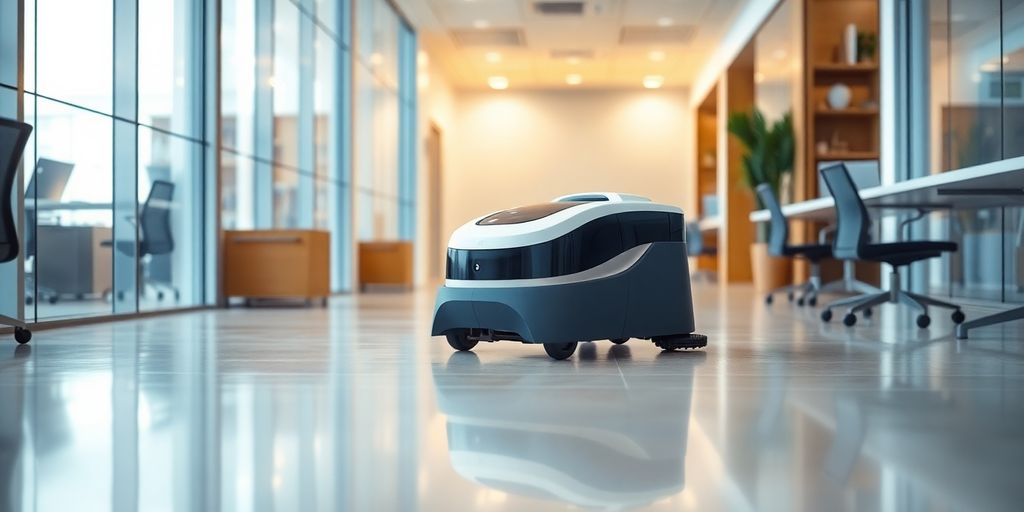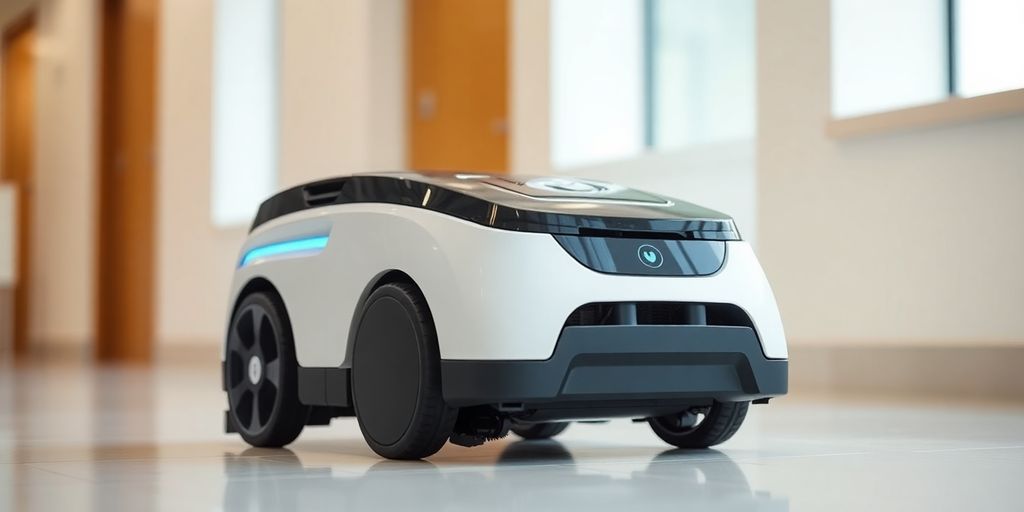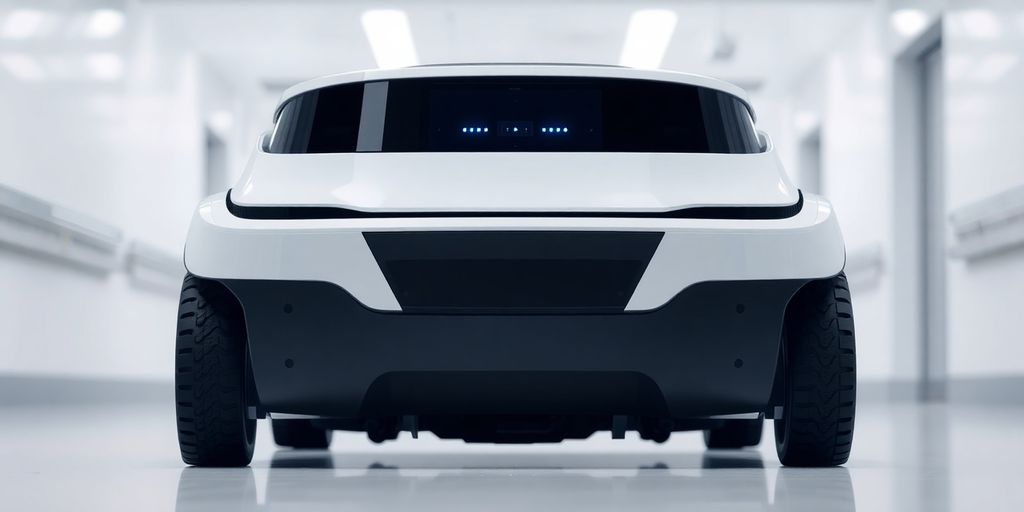Cleaning Operations robots for efficiency
Cleaning operations robots are changing how we keep our spaces tidy and organized. These robots, powered by artificial intelligence, are designed to make cleaning easier, faster, and more effective. This guide will help you understand what cleaning operations robots are, how they work, and the benefits they bring to different industries.
Key Takeaways
Cleaning operations robots help save time and effort in cleaning tasks.
These robots can work in many places, like offices, schools, and hospitals.
Sherpa robots have special features that make them stand out from others.
Using robots can lead to better cleaning results and happier workers.
The future of cleaning robots looks bright with new ideas and eco-friendly options.
Introduction to Cleaning Operations Robots

What Are Autonomous Cleaning Operations Robots?
Cleaning operations robots are machines designed to automate the process of cleaning in various environments. They can perform tasks like vacuuming, mopping, and scrubbing floors without much human intervention. These robots are becoming essential in many industries, helping to save time and reduce labor costs by operating effectively with minimal supervision.
How Cleaning Robots Work
Cleaning robots are designed to automate and streamline cleaning operations, making them an essential tool for commercial spaces. These advanced machines use a combination of sensors, navigation systems, and cleaning solutions to efficiently complete cleaning tasks. Here’s a breakdown of how cleaning robots work:
Navigation and Mapping: Cleaning robots use advanced sensors and mapping technology to navigate through commercial spaces, creating a detailed map of the area to be cleaned. This allows them to plan the most efficient cleaning route, ensuring no spot is missed.
Cleaning Mode: Once the robot has mapped the area, it enters cleaning mode. Using its built-in cleaning solutions and tools, the robot performs a thorough cleaning of the space. Whether it’s vacuuming, mopping, or scrubbing, these robots are equipped to handle various cleaning tasks with precision.
Obstacle Detection: The robot’s sensors continuously scan the environment for obstacles. When an obstacle is detected, the robot adjusts its cleaning path to avoid collisions, ensuring a safe and efficient cleaning process. This feature is particularly useful in busy commercial spaces where furniture and other items may be moved frequently.
Real-time Monitoring: Many cleaning robots come equipped with real-time monitoring systems. This allows cleaning teams to track the robot’s progress and receive notifications when the cleaning process is complete. This feature ensures that the cleaning operations are running smoothly and any issues can be addressed promptly.
Types of Cleaning Robots
There are various types of cleaning robots designed to cater to different cleaning needs and commercial spaces. Some of the most common types of cleaning robots include:
Autonomous Vacuum Cleaners: These robots are designed for thorough cleaning of floors and carpets. They use advanced navigation systems and sensors to detect dirt and debris, ensuring a consistent cleaning performance across large areas.
Mopping Robots: Equipped with advanced mopping systems, these robots use cleaning solutions and water to leave floors sparkling clean. They are ideal for hard surfaces like tiles and hardwood floors, providing a streak-free finish.
Scrubbing Robots: These robots use advanced scrubbing technology to deep clean floors, removing dirt, grime, and stubborn stains. They are particularly useful in high-traffic areas where a more intensive cleaning process is required.
UV-C Disinfecting Robots: These robots use UV-C light to disinfect surfaces, reducing the spread of germs and bacteria. They are especially valuable in environments where hygiene is critical, such as hospitals and healthcare facilities.
Benefits of Using Cleaning Operations Robots
Using cleaning robots offers several advantages:
Increased Efficiency: Robots can work continuously without breaks. Traditional cleaning methods are labor intensive, involving numerous steps and heavy use of chemicals.
Cost Savings: Over time, they can reduce the need for manual labor.
Consistent Quality: Robots provide uniform cleaning results every time.
Overview of the Cleaning Industry Trends
The cleaning industry is evolving with technology, particularly through the integration of robotic solutions. Here are some key trends:
Automation: More businesses are adopting robots for cleaning tasks.
Sustainability: There is a growing focus on eco-friendly cleaning solutions.
Advanced Technology: Innovations like AI and sensors are improving robot capabilities.
The future of cleaning is bright, with robots leading the way in efficiency and effectiveness.
| Trend | Description |
|---|---|
| Automation | Increased use of robots in cleaning tasks |
| Sustainability | Focus on eco-friendly practices |
| Advanced Technology | Use of AI and sensors for better performance |
Sherpa cleaning operations robots

Features of Sherpa Robots with Advanced Sensors
Sherpa robots are designed to make cleaning easier and more efficient. These robots can handle various tasks like window cleaning, floor scrubbing, and more. Here are some key features:
Autonomous operation: They can clean without human help.
Advanced sensors: These help them avoid obstacles.
Remote control: Users can operate them from a distance.
Applications in Various Industries
Sherpa robots are used in many places. They are popular in:
Commercial buildings: For cleaning large office spaces.
Hospitals: To maintain hygiene and cleanliness.
Schools: For keeping classrooms and hallways clean.
Comparative Analysis with Other Robots
When comparing Sherpa robots to other cleaning robots, they stand out in several ways:
| Feature | Sherpa Robots | Other Cleaning Robots |
|---|---|---|
| Autonomous Cleaning | Yes | Limited |
| Versatility | High | Medium |
| Cost Efficiency | High | Low |
Sherpa robots are changing the way we think about cleaning. They offer a safer and more efficient solution for various cleaning tasks, making them a great choice for many industries.
Implementing Cleaning Operations Robots

Steps to Integrate Robots into Your Workflow
Assess Your Needs: Determine what tasks you want the robots to handle. This could include floor cleaning, window washing, or other repetitive tasks.
Choose the Right Robot: Research different types of cleaning robots available and select one that fits your needs and budget.
Train Your Team: Ensure that your staff understands how to work alongside the robots effectively.
Overcoming Challenges with Cleaning Robot Integration
While cleaning robots offer numerous benefits, integrating them into commercial cleaning operations can present some challenges. Here are some common challenges and solutions:
Initial Investment: The initial investment in cleaning robots can be high. However, many companies offer financing options and leasing plans to make the technology more accessible. Over time, the cost savings from reduced labor and increased efficiency can offset the initial expenditure.
Training and Maintenance: Cleaning robots require regular maintenance and training to ensure optimal performance. Many manufacturers offer comprehensive training programs and maintenance services to support cleaning teams. Ensuring that staff are well-trained can minimize downtime and maximize the robots’ effectiveness.
Integration with Existing Cleaning Operations: Cleaning robots can be integrated with existing cleaning operations, allowing cleaning teams to focus on high-touch areas and specialized cleaning tasks. By complementing human efforts, robots can enhance overall cleaning efficiency and effectiveness.
Training Staff for Robot Operations
Hands-On Training: Provide practical sessions where staff can learn to operate the robots.
Safety Protocols: Teach employees about safety measures when working with robots.
Continuous Learning: Encourage staff to stay updated on new features and technologies related to the robots.
Maintenance and Support for Cleaning Robots
Regular Check-Ups: Schedule routine maintenance to keep the robots in good working condition.
User Manuals: Make sure all staff have access to the robot’s user manual for troubleshooting.
Support Services: Consider having a support service in place for any technical issues that may arise.
Implementing cleaning robots can greatly improve efficiency and reduce the workload on your staff, allowing them to focus on more important tasks.
Case Studies and Success Stories
Numerous companies have successfully integrated cleaning robots into their commercial cleaning operations, achieving significant benefits in terms of efficiency, productivity, and customer satisfaction. Here are a few case studies and success stories:
Denver Marriott: The Denver Marriott integrated cleaning robots into their housekeeping operations, achieving a 25% increase in efficiency and a significant reduction in labor costs. The robots handled routine cleaning tasks, allowing the housekeeping staff to focus on providing exceptional guest services.
BES Cleaning: BES Cleaning partnered with a cleaning robot manufacturer to integrate autonomous cleaning robots into their commercial cleaning operations. This resulted in a 30% increase in productivity and a 20% reduction in labor costs. The robots’ consistent cleaning performance also led to higher customer satisfaction rates.
Expert Insights and Testimonials
Industry experts and cleaning professionals have praised the benefits of cleaning robots, citing their ability to streamline cleaning operations, improve efficiency, and enhance customer satisfaction. Here are a few expert insights and testimonials:
“Cleaning robots have revolutionized the way we approach commercial cleaning. They’ve allowed us to focus on high-touch areas and specialized cleaning tasks, while the robots handle the more mundane tasks.” – Maria Villanza, Director of Housekeeping, Denver Marriott
“We’ve seen a significant reduction in labor costs and an increase in productivity since integrating cleaning robots into our operations. They’re a game-changer for the commercial cleaning industry.” – John Smith, CEO, BES Cleaning
By incorporating these insights and real-world examples, we can provide a comprehensive understanding of the benefits and practical applications of cleaning robots in commercial cleaning operations.
Future of Cleaning Operations Robots

Innovations on the Horizon
The future of cleaning operations robots is bright, with many exciting developments on the way. New technologies are being created that will make these robots even smarter and more efficient. For example, robots may soon be able to clean more types of surfaces and work in more challenging environments.
Impact on Workforce and Employment
As robots become more common in cleaning jobs, they will change the way people work. Here are some key points to consider:
Job Transformation: Some jobs may disappear, but new ones will be created in robot management and maintenance.
Skill Development: Workers will need to learn new skills to work alongside robots.
Increased Productivity: Robots can handle repetitive tasks, allowing human workers to focus on more complex duties.
Sustainability and Environmental Considerations
Cleaning robots are also becoming more eco-friendly. They can help reduce waste and use less water and energy. Here are some benefits:
Less Chemical Use: Many robots use fewer cleaning chemicals, which is better for the environment.
Energy Efficiency: Advanced robots are designed to use less power while performing their tasks.
Waste Reduction: Robots can help minimize waste by using precise cleaning methods.
The future of cleaning operations robots is not just about technology; it’s about creating a better work environment for everyone. Embracing these changes can lead to a more efficient and sustainable cleaning industry.
Conclusion
In summary, using cleaning robots can really help make our lives easier and our spaces cleaner. These robots save time and effort, allowing us to focus on other important tasks. They are smart and can work in many different places, from homes to offices. By choosing the right robot for your needs, you can improve how well you clean and keep everything tidy. As technology keeps getting better, cleaning robots will become even more helpful. So, if you want to make cleaning simpler and more efficient, consider adding a cleaning robot to your routine.
Frequently Asked Questions
What are cleaning robots?
Cleaning robots are machines designed to clean surfaces automatically. They can vacuum floors, wash windows, and do many other cleaning tasks without much help from people.
How can cleaning robots help businesses?
Cleaning robots can save time and money for businesses. They work fast and can clean large areas without getting tired, allowing employees to focus on other important tasks.
What industries use cleaning robots?
Many industries use cleaning robots, including hotels, hospitals, and offices. They help keep these places clean and safe for everyone.
How do I start using cleaning robots in my business?
To start using cleaning robots, first, choose the right robot for your needs. Then, train your staff to use it and set up a plan for regular cleaning.
What should I do if the robot breaks down?
If the cleaning robot stops working, check the manual for troubleshooting tips. You can also contact the manufacturer for help or repairs.
Are cleaning robots good for the environment?
Yes, many cleaning robots are designed to be eco-friendly. They use less water and energy compared to traditional cleaning methods, which is better for the planet.
